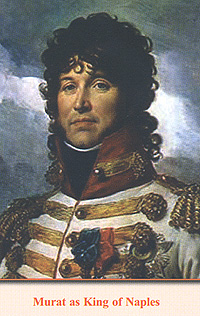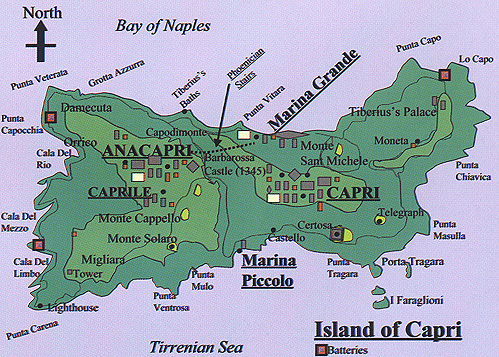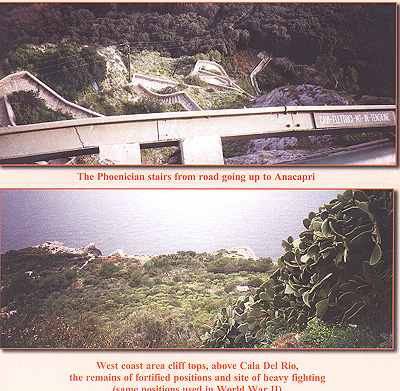Battle of Capri 1808
Murat's Victory Against the English
by Robert Fletcher, FINS, USA
| |
Joachim Murat, Napoleon's brother-in-law, was appointed King of Naples, titled as “Gioacchino Napoleone” (Joachim Napoleon) by imperial decree of July 15, 1808. Murat delayed his arrival, not reaching the border until the fifth of September where he was met by French and Neapolitan authorities. On the seventh of September, he finally entered the city of Naples, capital of his reign. Murat as King of Naples On the eighth, Murat took command, issuing orders and making immediate changes in law and policy, attempting to put the kingdom's affairs in order. From the Royal palace in Naples, Murat was shown an unpleasant reminder of the ongoing war, the island of Capri in the bay of Naples still in enemy hands. Capri had been invaded on May 11,1806 by the English while Napoleon's brother Joseph ruled. Since then, the island had been garrisoned by English troops. Joseph, as king of Naples, had been unable to plan or implement an expedition to take the island, due to a lack of expediency and an efficient Bourbon spy network. Murat planned to quickly change this situation, with an expedition to capture Capri. Even before the attack plan was written, troops had been gathered on Murat's orders as early as the 28th September. The Neapolitan Minister of War and Police, Antoine Christophe Saliceti, had his own network of spies and informers reporting on Capri and the English forces.
Landing sites considered for the attack were studied based on poor maps and information from Saliceti’s spies. A Neapolitan engineering officer, Pietro Colletta, was sent to study Capri from a small boat, dressed as a sailor. His recommended landing area was to attack at Cala del Limbo or Punta Carena. On October 2, Murat revised the final plan for the attack of Capri and presented it to General Jean Maximilien Lamarque for immediate execution, with a letter appointing him as the expedition commander. The plan called for 3 attacks to be conducted on the island, 2 feints at the ports and the main attack to fall on Punta Carena. The expedition was to set sail at midnight on the third of October. The “Island Fortress” of Capri
Other structures on the island included several walled villas, old fortification towers, and churches. The town of Capri was connected to that of Anacapri by a single zigzag stairwell road, called the Phoenician stairs of 552 steps, and a Cliffside donkey trail known as “il Passetiello” (the little passage). The island's houses, churches, and villas, were constructed of local island stone and limestone. Most of the buildings were left in a natural state; others painted in light colors, predominately white. Neapolitan government buildings were painted Pompeian red or gray as under Bourbon rule. The island fortifications consisted of a number of old structures and a few new cannon emplacements. Several small forts and fortified towers were located at Castello, San Michele, Santa Maria Cetrella, and Santa Maria Soccorso. The town of Capri was enclosed by high stone walls and wooden gates. Artillery emplacements of 32, 36, and 37 pound cannon had been sited at Castiglione (2 guns), San Michele (2), Santa Maria Soccorso (1), and at the port of Capri, Marina Grande (2). Anacapri was armed with some 6 or 7 short cannon of a smaller caliber (probably naval carronades or 4pdr cannon). The possible beach landing area Cala del Limbo had been heavily fortified as possible with traps, falls, ground works, and a battery of two cannon. The British referred to the island as “little Gibraltar”. Battle of Capri 1808
The Invasion From the Beach to Anacapri The Siege of Capri Epilogue Jumbo Photos of Capri (very slow: 362K) Back to Table of Contents -- First Empire # 78 Back to First Empire List of Issues Back to MagWeb Master Magazine List © Copyright 2004 by First Empire. This article appears in MagWeb.com (Magazine Web) on the Internet World Wide Web. Other articles from military history and related magazines are available at http://www.magweb.com |

 According to Saliceti’s spies, the number of English soldiers on Capri was between 5-600 men, under
the command of Colonel Hudson Lowe. Murat, armed with this information, formed a
staff composed of French and Neapolitan officers and authorities (Saliceti, Manzi, Colletta,
and Franceschi) to plan an attack on Capri.
According to Saliceti’s spies, the number of English soldiers on Capri was between 5-600 men, under
the command of Colonel Hudson Lowe. Murat, armed with this information, formed a
staff composed of French and Neapolitan officers and authorities (Saliceti, Manzi, Colletta,
and Franceschi) to plan an attack on Capri.
 The island of Capri is about 10 square kilometers large and only some 31 kilometers
distant from Naples. It is an island with two mountainous ends, east (Monte Tuoro), west
(Monte Solaro, Monte S.Maria), and a valley like area in the centre. Beaches are located at Marina Grande and Marina
Piccola on both sides of this valley. The remainder of the Capri coastline
has high-shelved cliffs and rock beaches. The island is sparsely forested
with low brush and ground cover, some trees, and cultivated vineyard
hillsides. In 1808, the only two towns on the island were Capri and
Anacapri.
The island of Capri is about 10 square kilometers large and only some 31 kilometers
distant from Naples. It is an island with two mountainous ends, east (Monte Tuoro), west
(Monte Solaro, Monte S.Maria), and a valley like area in the centre. Beaches are located at Marina Grande and Marina
Piccola on both sides of this valley. The remainder of the Capri coastline
has high-shelved cliffs and rock beaches. The island is sparsely forested
with low brush and ground cover, some trees, and cultivated vineyard
hillsides. In 1808, the only two towns on the island were Capri and
Anacapri.